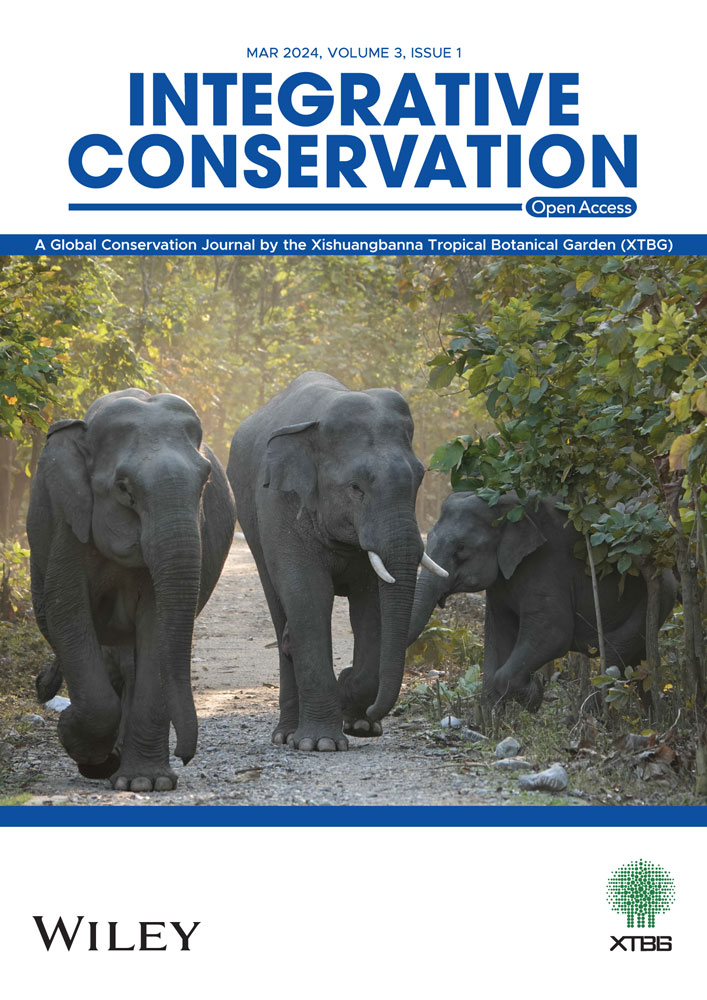Turtles and tortoises losing the race: Ecology and conservation of Testudines in Indawgyi Lake, Myanmar
“输了比赛”的龟:缅甸印多吉湖的龟鳖类生态与保护
“ြမန်မာနိုင်ငံ၊ အင်းေတာ်ြကီးကန်သဘာဝ ေဘးမဲ့ေတာအတွင်းရှိ သဘာဝေရချိုလိပ်နှင့် ကုန်းလိပ်များ၏ ေဂဟစနစ်ယိုယွင်းမှုနှင့် ထိန်းသိမ်းေစာင့်ေရှာက်ြခင်းသုေတသနစာတမ်း"
Editor-in-Chief & Handling Editor: Ahimsa Campos-Arceiz
Abstract
enTestudines (turtles and tortoises) rank among the most threatened vertebrates globally, with species in Asia particularly vulnerable due to exploitation, unregulated trade, habitat loss, and degradation. This study aimed to understand the ecology and conservation status of turtles and tortoises in the Indawgyi Lake basin. We conducted surveys along 47 transects, each 1–2 km in length, across four sampling periods (total distance covered = 74.9 km). Additionally, we also deployed four traps at three different locations to capture turtles during two of these sampling periods. In addition, we analyzed 14 soil samples collected from five locations to determine the nesting conditions of soft-shell turtles. Finally, we identified conservation concerns through semi-structured interviews with 146 local households, including fishermen and hunters, to gather local ecological knowledge (LEK) on the abundance, habitats, and breeding ecology of turtles and tortoises, as well as local conservation perspectives. Seven turtle and tortoise species were identified within the Indawgyi Lake basin. To our knowledge, two of these species, the Myanmar brown leaf turtle (Cyclemys fusca) and Oldham's leaf turtle (Cyclemys oldhamii), have yet to be officially documented in this area. Furthermore, an Amyda sp. (collected on 10 March 2019), known by the vernacular name “Late Par Tate,” is hitherto undescribed and is likely a newly discovered species. Our results showed disturbance (SW = 1.0) and higher organic matter (SW = 0.52) as the main estimators explaining the difference in nest observation frequency. Animal grazing areas had more nests than other sites affected by greater human disturbances. The local community identified hunting (44%), fishing (28%), and deforestation (13%) as the main activities threatening turtle and tortoise populations. The majority of turtles hunted were either consumed (over 43%) or sold to middlemen, who at times sold them on to foreign traders (less than 51%). Alarmingly, 99% of those interviewed expressed a notable deficiency in protection and conservation efforts by the Nature and Wildlife Conservation Division and NGOs. We advocate for enhanced conservation efforts, mainly through stronger enforcement, increased awareness, and the establishment of protection zones with restricted human access to facilitate the recovery of these populations, especially at nesting sites.
摘要
zh龟鳖类是全球受威胁最严重的脊椎动物之一,亚洲的龟鳖类物种尤其容易受到开发、非法贸易、栖息地丧失和退化的影响。本研究旨在了解因道支湖流域龟鳖类的生态和保护现状。我们在四个采样期沿着47个样带进行了调查,每个样带长1-2千米(总覆盖距离=74.9千米)。此外,我们还在其中两个取样时段的三个不同地点布设了四个诱捕器,以捕捉水龟。此外,我们还分析了从五个地点采集的14份土壤样本,以确定水龟的筑巢条件。最后,我们通过对146户当地家庭(包括渔民和猎人)进行半结构式访谈,收集了有关龟鳖类的数量、栖息地和繁殖生态的当地生态知识(LEK),以及当地的保护观点,从而确定了保护问题。在因道支湖流域发现了 7 种龟鳖类。据我们所知,其中两个物种,即灰舌摄龟(Cyclemys fusca)和欧氏摄龟(Cyclemys oldhamii),尚未在该地区得到正式记录。此外,一种方言名称为 "Late Par Tate"的亚洲鳖属物种(Amyda sp.) (采集于2019年3月10日),迄今尚未被描述,很可能是一个新发现的物种。我们的研究结果表明,干扰(SW=1.0)和较高的有机质(SW=0.52)是解释巢观察频率差异的主要估计因素。动物放牧区的巢穴数量多于受人类干扰较大的其他地点。当地社区认为,狩猎(44%)、捕鱼(28%)和砍伐森林(13%)是威胁水龟和陆龟种群的主要活动。大部分被猎杀的水龟和陆龟要么被食用(超过 43%),要么被卖给从事非法贸易的中间商(不到 51%)。令人震惊的是,99% 的受访者表示,自然与野生动物保护部和非政府组织在保护和保育工作方面存在明显不足。我们主张加强保护工作,主要是通过加强执法、提高意识和建立限制人类进入的保护区,以促进这些种群的恢复,尤其是在筑巢区。【审阅:Ong Lisa】
သုတေသနအကျဉ်းချုပ်
myTestudines သည်&;ကမ္ဘာပေါ်တွင် ခြိမ်းခြောက်မှုအရှိဆုံး ကျောရိုးရှိသတ္တဝါများဖြစ်ကြပီး အာရှနိုင်ငံများ တွင် ဖမ်းဆီးသတ်ဖြတ်ခြင်း၊ တင်ပို့ရောင်းချခြင်းနှင့် နေထိုင်ကျက်စားမှုများ ဆုံးရှုံးရခြင်းတို့ကြောင့် ထိခိုက်လွယ်သည့် အဆင့်သို့ သတ်မှတ်ခြင်းခံထားရသည်။ ဤလေ့လာမှုသည် အင်းတော်ကြီးကန် မြစ်ဝှမ်းရှိ ရေချိုလိပ်များနှင့်ကုန်းတွင်းလိပ်များ၏ ဂေဟစနစ်နှင့် ထိန်းသိမ်းရေးအခြေအနေများကို နားလည်စေရန် ရည်ရွယ်ပါသည်။ စစ်တမ်းနမူနာကောက်ယူသည့်ကာလ လေးခုအတွင်း ၁-၂ ကီလိုမီတာရှည်သော transects ၄၇ ခုတစ်လျှောက် (စုစုပေါင်းအကွာအဝေး = 74.9 ကီလိုမီတာ) ကို စစ်တမ်းကောက်ယူခဲ့သည်။ ထို့အပြင် အဆိုပါစစ်တမ်းနမူနာကာလနှစ်ခုအတွင်း လိပ်များကိုဖမ်းယူရန် ထောင်ချောက်လေးခုကို နေရာသုံးခုတွင် ဖြန့်ကျက်ချထားခဲ့သည်။ မြေနမူနာ ၁၄ ခုကိုလည်း နေရာ ငါးခုမှကောက်ယူပြီး အခွံပျော့လိပ်များ၏ အသိုက်အခြေအနေများကို ဆုံးဖြတ်ရန် သုတေသနပြုလုပ်ခဲ့ ပါသည်။ တံငါသည်များနှင့် မုဆိုးများပါဝင်သည့် ဒေသခံအိမ်ထောင်စု ၁၄၆ စုဖြင့် ရေချိုလိပ်နှင့် ကုန်းတွင်းလိပ်များ ပေါများကြွယ်ဝမှု၊ နေထိုင်ကျက်စားမှုနှင့် မျိုးပွားခြင်းများအတွက် ဒေသခံများ၏ ဂေဟစနစ်ဆိုင်ရာ အသိပညာများ စုဆောင်းရန်အတွက် ထိန်းသိမ်းရေးဆိုင်ရာ အတွေးအမြင်များကို ဖော်ထုတ်တွေ့ရှိခဲ့သည်။ အင်းတော်ကြီးကန်အတွင်း၌ ရေချိုလိပ်နှင့် ကုန်းတွင်းလိပ်မျိုးစိတ် ခုနစ်မျိုး တို့ကို ဖော်ထုတ်တွေ့ရှိခဲ့သည်။ ကျွန်ုပ်တို့ သိရှိနားလည်ထား သည့်အတိုင်း အဆိုပါမျိုးစိတ် နှစ်ခုဖြစ်သည့် Myanmar Brown Leaf Turtle (Cyclemys fusca) နှင့် Oldham's leaf turtle (Cyclemys oldhamii) တို့သည် ဤဒေသတွင် တရားဝင် မှတ်တမ်းတင်ခြင်း မရှိသေးပေ။ ထို့အပြင် Amyda sp. (၂၀၁၉ ခုနှစ် မတ်လ ၁၀ ရက်) တွင် စုဆောင်းထားသော ဒေသအမည် “Late Par Tate” သည် ယခုအချိန်အထိ ဖော်ပြခြင်းမပြုရသေးဘဲ အသစ်တွေ့ရှိထားသော မျိုးစိတ်တစ်ခုဖြစ်ဖွယ်ရှိသည်။ ကျွန်ုပ်တို့၏ရလဒ်များသည် disturbance (SW = 1.0) နှင့် ပိုမိုမြင့်မားသော organic matter (SW = 0.52) တို့သည် အသိုက်တွေ့ရှိမှုအကြိမ်ရေ ကွာခြားမှုကို အဓိကညွှန်းဆိုပေးသော အရာများဖြစ်ခဲ့ပါသည်။ တိရစ္ဆာန်စားကျက်နေရာများတွင် လူသားများနှောင့်ယှက်မှုဒဏ်ခံရသော အခြားနေရာများထက် အသိုက်ပိုများပါသည်။ အမဲလိုက်ခြင်း (၄၄%)၊ ငါးဖမ်းခြင်း (၂၈%) နှင့် သစ်တောပြုန်းတီးမှု (၁၃%) တို့ကို ရေချိုလိပ်နှင့်ကုန်းတွင်းလိပ်များကို ခြိမ်းခြောက်သည့် အဓိကလုပ်ဆောင်မှုများအဖြစ် ဒေသခံ အသိုင်းအဝိုင်းက သတ်မှတ်ခဲ့သည်။ အမဲလိုက် လိပ်အများစု (၄၃%) ကျော်ကို စားသုံးခြင်း သို့မဟုတ် ပွဲစားများထံ ရောင်းချခဲ့ပြီး တစ်ခါတစ်ရံတွင် ၎င်းတို့ကို နိုင်ငံခြားကုန်သည်များထံ ရောင်းချခြင်း (၅၁%) အောက်သာ ရှိခဲ့သည်။ ထိတ်လန့်စရာကောင်းသည်မှာ တွေ့ဆုံမေးမြန်းခံရသူများ၏ ၉၉% သည် သဘာဝနှင့် တောရိုင်းတိရစ္ဆာန်ထိန်းသိမ်းရေးဌာနနှင့် NGO များ၏ ကာကွယ်ရေးနှင့် ထိန်းသိမ်းရေး ကြိုးပမ်းမှုတွင် သိသိသာသာချို့တဲ့နေကြောင်း ဖော်ပြခဲ့သည်။ အဓိကအားဖြင့် ဥပဒေစိုးမိုးခြင်း၊ အသိ ပညာမြှင့်တင်ခြင်းနှင့် ဒေသခံများဝင်ရောက်ရန် ကန့်သတ်ထားသော အကာအကွယ်ဇုန်များ တည်ထောင်ခြင်းဖြင့် အသိုက်မြေနေရာများတိုးမြှင့်ထိန်းသိမ်းရန် လိုအပ်ပါသည်။
Plain language summary
enTurtles and tortoises, among the most endangered vertebrates globally, face severe threats in Asia due to overexploitation, illegal trade, and habitat destruction. We conducted a study around Indawgyi Lake—setting traps to survey diversity, analyzing soil samples to assess nesting conditions, and conducting interviews with locals to gain deeper insights into the population, habitats, breeding behaviors, and conservation issues related to Testudines. Our research identified seven turtle species, including two previously undocumented in the area (Myanmar brown leaf turtle and Oldham's leaf turtle) and a potentially new species (Amyda sp.). Interestingly, our findings indicate that turtles prefer nesting in areas with minimal human disturbance, even though these areas have higher organic matter content in the soil, which is typically avoided due to the risk it poses to turtle embryos. Local communities identified hunting, fishing, and deforestation as the most significant threats, with most captured turtles being consumed or sold to intermediaries involved in illegal trade. There was a notable consensus among the locals regarding the inadequacy of current conservation efforts by both authorities and NGOs. Our study underscores the need for stricter laws, increased public awareness, and the establishment of buffer zones that restrict human access to critical nesting sites to support the recovery of these populations.
简明语言摘要
zh水龟和陆龟是全球最濒危的脊椎动物之一,由于过度开发、非法贸易和栖息地破坏,它们在亚洲面临着严重威胁。我们在因道支湖周围开展了一项研究——设置诱捕器调查多样性,分析土壤样本以评估筑巢条件,并与当地人进行访谈,以深入了解龟鳖类动物的数量、栖息地、繁殖行为和保护问题。我们的研究发现了七个龟鳖类物种,包括两个以前在该地区未曾记录的物种(灰舌摄龟和欧氏摄龟)和一个潜在的新物种(亚洲鳖属)。有趣的是,我们的研究结果表明,水龟更喜欢在人类干扰最少的地区筑巢,尽管这些地区的土壤中有机物含量较高。由于有机物对水龟胚胎构成风险,通常水龟会避免在这些地区筑巢。当地社区认为狩猎、捕鱼和砍伐森林是最大的威胁,捕获的水龟大多被食用或卖给从事非法贸易的中间商。当地人对当局和非政府组织当前保护工作的不足达成了明显的共识。我们的研究强调,支持这些种群的恢复须制定更严格的法律,提高公众意识,并建立缓冲区,限制人类进入重要的筑巢区。
အကျဉ်းချုပ်ရေးသားဖော်ပြချက်
myကမ္ဘာပေါ်တွင် မျိုးတုံးပျောက်ကွယ်လုနီးပါးဖြစ်နေသော ကျောရိုးရှိသတ္တဝါများထဲမှ ရေချိုလိပ်များနှင့် ကုန်းတွင်းလိပ်များသည် အာရှတွင် ပြင်းထန်သော ခြိမ်းခြောက်မှုများနှင့် ရင်ဆိုင်နေရပြီး၊ အလွန်အကျွံ ဖမ်းဆီးသတ်ဖြတ်ခြင်း၊ တရားမဝင်ရောင်းဝယ်ဖောက်ကားခြင်းနှင့် နေရင်းဒေသများ ပျက်စီးခြင်းတို့ ကြောင့် ဖြစ်သည်။ ကျွန်ုပ်တို့သည် အင်းတော်ကြီးကန်တစ်ဝိုက်တွင် လိပ်ထောင်ချောက်များတပ်ဆင်၍ လိပ်များ၏ diversity ကိုလေ့လာခြင်း၊ အသိုက်အခြေအနေများကိုလေ့လာရန် မြေနမူနာများ ကောက်ယူခြင်း၊ population၊ နေထိုင်ကျက်စားရာနေရာ၊ မျိုးပွားခြင်းနှင့် ထိန်းသိမ်းမှုဆိုင်ရာအကြောင်း အရာများကို ဒေသခံများနှင့် တွေ့ဆုံမေးမြန်းမှုများ ပြုလုပ်ခဲ့ပါသည်။ အင်းတော်ကြီးဒေသတွင် ယခင်က အထောက်အထားမရှိသော လိပ်မျိုးစိတ်နှစ်ကောင် (Myanmar Brown Leaf turtle နှင့် Oldham's leaf turtle) နှင့် ဖြစ်နိုင်ချေရှိသော လိပ်မျိုးစိတ်အသစ် (Amyda sp.) တို့အပါအဝင် လိပ်မျိုးစိတ်ခုနစ်ခုကို ကျွန်ုပ်တို့၏သုတေသနပြုဖော်ထုတ်ခဲ့သည်။ စိတ်ဝင်စားစရာမှာ၊ လိပ်များသည် မြင့်မားသော soil organic matter ရှိသော်လည်း ဒေသခံများ၏ နှောက်ယှက်ဖျက်စီးမှုအနည်းဆုံးရှိသော ဧရိယာများတွင် လိပ်များသည် ဥလေ့ရှိကြသည်။ အမဲလိုက်ခြင်း၊ ငါးဖမ်းခြင်းနှင့် သစ်တောပြုန်းတီးခြင်းတို့ကို အကြီးမား ဆုံး ခြိမ်းခြောက်မှုအဖြစ် ဒေသခံအသိုင်းအဝိုင်းများက မီးမောင်းထိုးပြပြီး ဖမ်းမိထားသော လိပ်အများစု သည် တရားမဝင်ကုန်သွယ်မှုတွင် ပါဝင်ပတ်သက်နေသည့်ပွဲစားများထံ ရောင်းချခြင်း သို့မဟုတ် သတ်ဖြတ်စားသုံးခြင်းတို့ဖြင့် ခြိမ်းခြောက်ခံရလျှက်ရှိပါသည်။ ဌာနဆိုင်ရာများနှင့် NGO နှစ်ခုလုံးမှ ထိရောက်သော ထိန်းသိမ်းရေး ကြိုးပမ်းမှုများ အားနည်းနေကြောင်း ဖော်ပြခဲ့ကြသည်။ လိပ်မျိုးစိတ် များ၏ ဦးရေကို တိုးမြှင့်ရေးအတွက် တင်းကျပ်သောဥပဒေများချမှတ်ခြင်း၊ ဒေသခံများ အသိပညာ မြှင့်တင်ခြင်းလုပ်ငန်းများနှင့် အသိုက်မြေနေရာများကို buffer zones များတည်ထောင်ခြင်းလုပ်ငန်းများ ဆောင်ရွက်ရန် မိမိတို့၏ သုတေသနတွေ့ရှိချက်များမှ ဖော်ပြထားပါသည်။
Practitioner points
en
-
The Indawgyi Lake Wildlife Sanctuary, globally recognized for its ecological importance as a UNESCO Biosphere Reserve, Ramsar Site, Important Bird Area, part of the East Asian-Australasian Flyway Partnership Network, and an ASEAN Heritage Park, is a critical habitat for Myanmar's tortoises and turtles.
-
Despite the area's protected status, these species face significant threats from human activities such as hunting, fishing, and deforestation, leading them to nest in suboptimal conditions to avoid human disturbance.
-
Local communities have reported insufficient conservation action, leading us to highlight the need for improved law enforcement, increased public awareness, more protected areas, and community engagement to facilitate the recovery of turtle and tortoise populations.
Highlights
zh实践者要点:
- 1.
因道支湖野生动物保护区作为联合国教科文组织生物圈保护区、拉姆萨尔湿地、重点鸟类区、东亚-澳大利西亚迁飞道合作网络的一部分以及东盟遗产公园,其生态重要性得到了全球的认可,是缅甸陆龟和水龟的重要栖息地。
- 2.
尽管该地区已被列为保护区,这些物种仍面临着狩猎、捕鱼和砍伐森林等人类活动的严重威胁,导致它们为避免人类干扰,不得不在非理想条件下筑巢。
- 3.
当地社区报告的保护行动不足,因此我们强调需要改进执法、提高公众意识、增加保护区和社区参与,以促进水龟和陆龟种群的恢复。
သုတေသနပြုသူ၏ ဖော်ပြချက်များ
my
-
အင်းတော်ကြီး တောရိုင်းတိရစ္ဆာန်ဘေးမဲ့တောသည် ၎င်း၏ ဂေဟဗေဒစနစ်ဆိုင်ရာ အရေးပါမှု (UNESCO Biosphere Reserve၊ Ramsar Site၊ အရေးကြီးသောငှက်ဧရိယာ၊ အရှေ့အာရှ-သြစတြေးလျ Flyway Partnership ကွန်ရက်အတွင်း နေရာတစ်ခု၊ နှင့် ASEAN Heritage site Park) ဖြင့် အသိအမှတ်ပြုခံထားရပြီး၊ မြန်မာနိုင်ငံရှိ ရေချိုလိပ်များနှင့် ကုန်းတွင်းလိပ်များ၏ နေထိုင်ကျက်စားရာ နေရာလည်းဖြစ်သည်။
-
ကာကွယ်ထိန်းသိမ်းစောင့်ရှောက်ခြင်း ဥပဒေများတည်ရှိနေသော်လည်း လိပ်မျိုးစိတ်များသည် အမဲလိုက်ခြင်း၊ ငါးဖမ်းခြင်းနှင့် သစ်တောပြုန်းတီးခြင်းတို့ကြောင့် မျိုးတုန်းပျောက်ကွယ်မှု အန္တရာယ်ဖြင့် ခြိမ်းခြောက်ခံရပြီး လူသားများကို ရှောင်ရှားရန် အကောင်းဆုံးအခြေအနေများ တွင် အသိုက်ပြုလုပ်ကြသည်။
-
ဒေသခံများမှ မလုံလောက်သည့် ထိန်းသိမ်းစောင့်ရှောက်ရေး လုပ်ဆောင်ချက်တွေကို မီးမောင်း ထိုးပြထားပြီး မျိုးစိတ်ပြန်လည်ထူထောင်ရေးမှာ ပိုမိုကောင်းမွန်တဲ့ ပြဋ္ဌာန်းမှု၊ အသိပညာပေးမှု၊ သဘာဝထိန်းသိမ်းရေးနယ်မြေတွေနဲ့ လူ့အဖွဲ့အစည်းတွေရဲ့ ပါဝင်ပတ်သက်မှု လိုအပ်ကြောင်း မိမိတို့ သုတေသနတွေ့ရှိချက်များမှထောက်ခံပြောဆိုထားပါသည်။
1 INTRODUCTION
The Testudines, that is, turtles and tortoises, are one of the most threatened groups of vertebrates (Buhlmann et al., 2009) due to over-exploitation, unregulated trade, habitat loss, and degradation (Van Dijk et al., 2000; Gibbon et al., 2000; Turtle Conservation Fund, 2002). Myanmar, a country recognized as a biodiversity hotspot, is home to some of the rarest tropical flora and fauna, including more than 37 species of Chelonians (sea turtles, tortoises, softshell turtles, and terrapins) (Uetz et al., 2023). The majority of the Testudines (at least eight) (Kutchling et al., 2004; Myanmar Conservation and Development Program MCDP, 2012; Shwe & Grindley, 2012) are found in Indawgyi Lake, Myanmar's largest freshwater lake; and most are classified either as endangered or vulnerable. Despite legal protection under the Wildlife Law (SLORC, 1994), conservation efforts for these species in Myanmar are often insufficient and untimely.
The intrinsic traits of turtles and tortoises, such as their long life expectancy and relatively late sexual maturity—often beyond 7 years—render them particularly susceptible to mortality and various threats (Bu et al., 2023). Turtle and tortoise embryos are also sensitive to microhabitat characteristics. Soil temperature, for instance, plays a crucial role in determining the embryo incubation period, as well as the development and sex of hatchlings (Ernst et al., 1994; Friends of Algonquin Park [FAP], 2005). According to Ernst et al. (1994), soil temperatures ranging from 22°C to 27°C result in the hatching of exclusively male offspring, while temperatures between 30°C and 32°C yield only females; temperatures at 20°C and 28°C can produce offspring of either sex. Soil salinity and moisture content can also affect hatchlings' development and survival rate in turtle nests (Bower et al., 2013; Delmas et al., 2008; Finkler, 2006). Higher soil salinity tends to reduce the survival rates of freshwater turtle hatchlings to around 39% as compared to freshwater substrate areas (Bower et al., 2013). Soils rich in clay or soil organic matter, which retain more water, could potentially suffocate turtle embryos (Costanzo et al., 2001; Delmas et al., 2008; Finkler, 2006). In contrast, soils with low organic matter, such as sandy loam, help increase heat capacity and create favorable conditions for incubating embryos (Costanzo et al., 2001; Hughes & Brooks, 2006; Hughes et al., 2009). These compounded factors elucidate why female turtles prefer specific environmental conditions for their hatchlings (Restrepo et al., 2006; Roosenburg, 1996; Wilson, 1998) and why certain species habitually return to the same nesting sites (Congdon et al., 1983; Jackson & Walker, 1997; Loncke & Obbard, 1977). Consequently, turtle nesting activities modify the conditions of surrounding natural habitats, including the temperature and moisture content of soils (Ackerman, 2009; Bonach et al., 2007; Marchand & Litvaitis, 2004). These alterations can indirectly impact the biotic and abiotic conditions of the habitat, influencing resources shared by other species.
Supporting a diverse array of globally threatened wildlife (MOECAF, 2014), the Indawgyi Lake Wildlife Sanctuary (ILWS) holds several well-known designations, including being a UNESCO Biosphere Reserve (UNESCO, 2019), a Ramsar Site (Ramsar, 2016), an Important Bird Area (IBA, 2004), a site within the East Asian-Australasian Flyway Partnership network (EAAFP, 2014), and an ASEAN Heritage site Park (ASEAN Heritage Parks, 2015). Despite its ecological significance, the diversity and breeding ecology of turtles and tortoises in the area remain less studied compared to that of birds and fishes, with scant research on the breeding ecology of wild softshell turtles in Myanmar (e.g., by Fauna and Flora International, 2023). The ILWS is home to more than 50,000 people from three primary ethnic groups: Shan, Bamar (formerly known as Burmese), and Kachin (Forest Department, 2018; Than & Kraas, 2020; Thazin & Eivin, 2020). Many of these communities rely on agriculture, fishing, subsistence livestock farming, and independent ventures such as gold mining and the collection of non-timber forest products for their livelihoods (Karlsen & Røskaft, 2020; Than et al., 2011). Hence, incorporating local perspectives and gathering local ecological knowledge (LEK) can significantly contribute to conservation efforts in the area (Gadgil et al., 1993; Nabhan & Martinez, 2012; Newton et al., 2008).
This study aims to enhance our understanding of turtle and tortoise conservation efforts in the Indawgyi Lake region. Specifically, the objectives are to (1) assess the species composition of turtles and tortoises, (2) investigate their breeding environments with a focus on disturbances and soil conditions around turtle nests, and (3) summarize the conservation concerns related to Indawgyi turtles and tortoises through semistructural interviews with the local community. For the second objective, the study also aims to test the hypothesis that turtles are selecting nesting sites due to differences in the abiotic conditions of the soils. We anticipate finding more nests in areas characterized by low organic matter, low soil salinity, and minimal disturbance.
2 MATERIALS AND METHODS
2.1 Study area
The study was conducted at Indawgyi Lake within the ILWS (24° 56′ N, 96° 39′ E) in Northern Kachin State, Myanmar (Figure 1). Myanmar is home to three large inland lakes designated as wildlife sanctuaries: Indawgyi Lake (the largest), Inlay Lake (the second largest), and Moeyungyi Wetland (Myanmar's first Ramsar site). Surrounded by mountain ranges, ILWS is positioned at an elevation ranging from 300 to 1300 m above sea level. The lake extends 23.8 km from north to south, with a maximum width of 10 km. Its depth ranges from 15.9 to 22.2 m, covering a catchment area of 850 km2 (Davies et al., 2004). Over 30 streams flow into the lake, but the Indaw Stream, a tributary of the Ayeryarwady—Myanmar's largest river—is the lake's only outlet (Than et al., 2011).
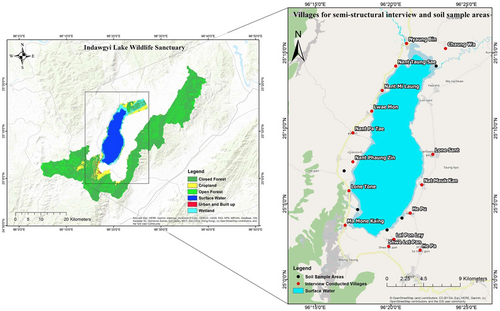
The Indawgyi Lake is facing environmental pressures due to overfishing, destructive fishing practices, waste management issues, and sediment and mercury pollution from mining activities in the area. These pressures not only threaten the lake's ecosystem but also endanger its diverse aquatic life, including water birds, turtles, and tortoises. Eight turtle and tortoise species are reported to occur in the Indawgyi Wildlife Sanctuary (Kutchling et al., 2004; Myanmar Conservation and Development Program [MCDP], 2012; Shwe & Grindley, 2012) (Table 1), most of which are classified as vulnerable or endangered (Table 1). Of these species, the Burmese peacock softshell turtle (Nissonia formosa), the Burmese narrow-headed softshell turtle (Chitra vandijki), the Burmese eyed turtle (Morenia ocellata), and the Burmese box turtle (Coura amboinensis lineata) are endemic to Myanmar.
| Family | Scientific name | Common name | IUCN |
|---|---|---|---|
| Bataguridae | Cuora amboinensis lineata | Myammar box turtle | Vulnerable |
| Bataguridae | Cyclemys dentata | Asian leaf turtle | Near threatened |
| Geoemydidae | Morenia ocellata | Burmese eyed turtle | Endangered |
| Testudinidae | Indotestudo elongata | Yellow tortoise | Critically endangered |
| Testudinidae | Manouria emys | Sian brown tortoise | Critically endangered |
| Trionychidae | Amyda cartilaginea | Asiatic softshell turtle | Vulnerable |
| Trionychidae | Nilssonia formosa | Burmese peacock softshell Turtle | Critically endangered |
| Trionychidae | Chirta vandijki | Burmese narrow-headed Softshell Turtle | Critically endangered |
- Abbreviation: IUCN, The International Union for Conservation of Nature.
2.2 Diversity of turtles and tortoises
Forty-seven transects, ranging from 1 to 2 km in length (total distance = 74.9 km), were established along the edge of Indawgyi Lake to detect the presence of turtles and tortoises. We conducted four field surveys during the nesting seasons in October 2018, February–March 2019, April–June 2019, and October–November 2019 (Hossain & Sarker, 1993; Rashid & Swingland, 1997), aiming to increase the likelihood of spotting turtles and tortoises. Additionally, four turtle traps were set up in Nant Khun Chin Stream, Nant Phaung Zin Stream, and Lae Pon Lay Waterside and checked for captured turtles. Local villagers were asked to notify us of any turtles caught in fishing nets or other traps. Each location where turtles and tortoises were found was recorded using GPS. We identified turtle and tortoise species following the “Photographic guides of the freshwater turtles and tortoises of Myanmar” (Platt et al., 2014) and “Turtles of the World Vol. 4: East and Southeast Asia” (Vetter & VanDijk, 2006).
2.3 Location of damaged softshell turtle nests and breeding site soil conditions
We located 14 known turtle nesting sites with the assistance of local hunters to determine the nesting habits of the Indawgyi turtles and tortoises at five locations: (1) Lae Pon Lay Waterside (lat: 25.054, long: 96.329), (2) Hepa Gyi Stream Mouth (lat: 25.067, long: 96.346), (3) Nant Yin Kha Stream (lat: 25.077, long: 96.297), (4) Nant Phaung Zin Stream (lat: 25.119, long: 96.281), and (5) Shwe Taung (lat: 25.236, long: 96.383) (Figure 1). The locations were separated by distances of 1–7 m. At each site, disturbances such as agricultural expansion, boat engines, water pollution, channels for agriculture, and grazing land for buffaloes and cows were documented. Soil temperature and soil moisture were measured using an RCYAGO 4-in-1 PH meter. Additionally, we collected 14 soil samples, each a 15.24 × 15.24 × 15.24 cm block to test for organic matter content, pH level, exchangeable Mg (Ex. Mg), soil moisture level, and soil texture at the Department of Agricultural Research, Yezin, Myanmar. Refer to Supporting Information S1: Table S1 for details of the variables collected.
No new nests were found at the nesting sites during our surveys. However, we encountered four old (damaged) nests and three test nests where turtles had dug but left no signs of eggs. We measured the dimensions (nest length, width, and depth in cm) and distance from the water (in m) of these nests.
2.4 LEK and conservation concerns
The ILWS is home to more than 50,000 people from approximately 8800 households across 36 villages (Forest Department, 2018). The local communities are primarily comprised of Shan and Bamar ethnic groups, with minorities such as the Kachin and migrants also present. The majority of residents around the banks of Indawgyi Lake are from the Shan (Shan-ni or Shan-Bamar) or Kachin group (Forest Department, 2018). Common livelihoods include fishing, agriculture, and mining activities, including gold and jade extraction. Local inhabitants play a crucial role in conservation efforts, as collecting plant species and hunting wildlife are parts of their livelihoods, and they carry a wealth of indigenous knowledge. LEK has been recognized as a pivotal resource for understanding ecological dynamics (Berkes et al., 2000; Ong et al., 2021) and informing ecosystem management (Joshi et al., 2004).
Here, we conducted semi-structural interviews with 146 households from the following villages (Figure 1): Lone Tone Village, Ma Mone Khaing Village, Nant Phaung Zin Village, Nant Patae Village, Lwae Mon Village, Nant Mi Laung Village, Nant Taung Sae Village, Nyaung Bin Village, Chaung Wa Village, Lae Pone Lay Village, Shwe Lat Pan Village, He Pa Village, Hepu Village, Nat Mauk Kan Village and Lone Sant Village. The participants, mainly fishermen and turtle hunters, possessed knowledge of turtle species, harvesting practices, NGO conservation projects, exploitation levels, and potential threats. Among them, 73.2% were native, while 26.8% were nonnative villagers who had migrated from other towns like Sagaing, Mandalay, and Shan State, drawn by livelihood opportunities in fishing and gold mining (Than et al., 2011). The questionnaire used for these interviews can be found in Supporting Information S1: Questionnaire S1.
The interview covered questions related to turtle and tortoise ecology, including participants’ perceptions of species prevalence, observation frequencies in different habitats, and noted nesting and hatching periods. Additionally, inquiries on hunting and conservation assessed the aims behind hunting and egg collection, penalties from the NWCD, involvement in NGO conservation activities, acknowledgment of their role in conservation, views on reducing hunting, identification of key threats, and the years when turtles and tortoises were scarce.
2.5 Data analysis
Statistical analyses were carried out using the R statistical environment 4.2.3 (R Core Team, 2023) and IBM SPSS Statistics 23.
2.5.1 Diversity of turtles and tortoises
We identified all species and summarized the measurements (mean ± SD) for all species found.
2.5.2 Breeding sites and effect of environmental factors on turtle nests
We adopted an information theory approach (Dormann et al., 2018) to examine the effects of soil variables (pH reaction, % OM, Ex. Mg, % moisture, soil texture class) and disturbance on the frequency of nests located (see Supporting Information S1: Table S1 for full details of variables tested). Given that no new nests were discovered and most information regarding the nests was provided by the turtle hunters (LEK), we assigned an index to represent the frequency of nests at each site as follows: (1) the number of damaged nests found at each site, when available, (2) “0.1” for sites identified as nesting spots where no nest was found, and (3) “0.5” for sites where turtles were sampled but no nest was discovered.
3 RESULTS
3.1 Diversity of turtles and tortoises
We found seven species of turtles and tortoises in Indawgyi Lake (Supporting Information S1: Table S2). Among these, one species, morphologically belonging to the softshell turtle genus Amyda, was undescribed (10 March 2019) (Figure 2; Table 2; Supporting Information S1: Table S2). Its vernacular name, “Late Par Tate,” describes its carapace pattern, reminiscent of Batik art found in traditional Indonesian fabric. The carapace is oval and yellowish, adorned with serial columns of spiny-like tubercles, and the plastron is white. The head of the turtle is reddish-gold, featuring a prominent tubercle on the neck and black stripes around its eyes. The turtle weighed 11.2 kg, with carapace length (CL) = 49 cm, carapace width (CW) = 42 cm, plastron length (PL) = 34 cm, plastron width (PW) = 26 cm, tail length (TL) = 2.5 cm, and tail width (TW) = 4.5 cm (Figure 2).
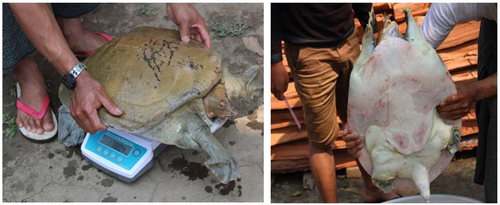
| Common name (N = 34) | Scientific name | IUCN red list |
|---|---|---|
| Burmese softshell turtle (n = 9) | Amyda ornata phayrei | Vulnerable |
| Location: Nant Khun Chin Stream, Hepu Village | ||
| Late Par Tate (n = 1) | Amyda sp. | No Data |
| Location: Indawgyi Lake | ||
| Burmese peacock softshell turtle (n = 3) | Nilssonia formosa | Critically Endangered |
| Location: Nant Phaung Zin Stream and Lae Pon Lay Waterside | ||
| Burmese box turtle (n = 5) | Cuora amboinensis lineata | Vulnerable |
| Location: Naung Khun Lake of Nyaung Bin Thar Village, Kyar Stream | ||
| Oldham's leaf turtle (n = 14) | Cyclemys oldhamii | Endangered |
| Location: Nant Khun Chin Stream, Kyar Stream, Yae Aye Stream and Nant Patae Stream | ||
| Myanmar brown-leaf turtle (n = 1) | Cyclemys fusca | Least Concern |
| Location: In the forest | ||
| Yellow tortoise (n = 1) | Indotestudo elongata | Critically Endangered |
| Location: Kyar Stream |
- Abbreviation: IUCN, The International Union for Conservation of Nature.
3.2 Breeding sites and effect of environmental factors on turtle nests
Among the identified nesting sites, four damaged nests were found at Shwe Taung (S5), an area frequented by grazing buffaloes and cows. No nests were detected at Hepa Gyi Stream Mouth (S2) or Nant Phaung Zin Stream (S4), but turtles were sampled at these sites. Lae Pon Lay Waterside (S1) and Nant Yin Stream (S3) were identified as potential nesting grounds by local hunters, but no nests or turtles were spotted.
In Shwe Taung (S5), test nests, that is, areas where turtles had dug potential nests (length × width × depth = 14.3 ± 2.8 × 12.8 ± 4.0 × 11.8, 11.8 ± 5.1 cm, n = 3) were on average smaller than the damaged nests (17.8 ± 3.3, 15.3 ± 4.6, 19.3 ± 4.6 cm, n = 4). Higher temperatures (28.3 ± 7.4°C) and shorter distances to water (3.5 ± 1.1 m) were recorded at the test nests in comparison to the damaged nests (22.5 ± 1.0°C, 14 ± 6 m; n = 4).
Disturbance was the main explanatory estimator for the differences in the frequency of nests found (sum of model weight, SW = 1, Table 3, Figure 3), followed by % OM (SW = 0.52), and pH reaction (SW = 0.1) (Supporting Information S1: Figure S1). The sites where buffaloes and cows were grazing (Shwe Taung) exhibited a higher number of nests than other sites, particularly those affected by agriculture and pollution. Additionally, areas with high organic matter and soils with a pH of around 6.0 also demonstrated an increased frequency of nests.
| Fixed effects | AICc | ΔAICc | Model weight | R2 |
|---|---|---|---|---|
| Model 1 (disturbance) | ||||
| Disturbance + % OM | 18.3 | 0 | 0.521 | 0.769 |
| Disturbance | 18.9 | 0.64 | 0.379 | |
| Disturbance – pH reaction | 21.6 | 3.29 | 0.1 |
- Note: Predictor variables tested include disturbance, pH reaction, % OM, Ex Mg, % moisture, and % sand.
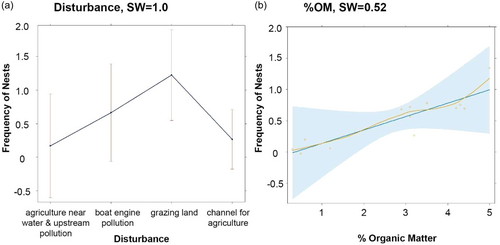
Soils surrounding the damaged nests at Nant Yin Kha Stream (S3) (median pH 5.0, range 5.0–5.5, n = 3) and Nant Phaung Zin (S4) (pH 5.0, range 5.0–5.2, n = 3) were more acidic than soils at Lay Pon Lay waterside (S1) (pH 6.6, range 6.0─6.7, n = 3), Hepa Gyi Stream (S2) (pH 6.0, range 5.9–6.1, n = 2), and Shwe Taung (S5)) (pH 6.0, range 6.0–6.0, n = 3) (Figure 4). The organic matter content of the soil at Hepa Gyi Stream (S2) (OM 0.4%, range 0.3–0.5, n = 2) was lower than at Lae Pon Lay Waterside (S1) (OM 1.2%, range 0.6–4.2, n = 3), Nant Yin Kha Stream (S3) (OM 3.5%, range 3.1–4.3, n = 3), Nant Phaung Zin Stream (S4) (OM 3.1%, range 2.9–4.4, n = 3), and Shwe Taung (S5) (OM 3.2%, range 1.8–5.0, n = 3) (Figure 4).
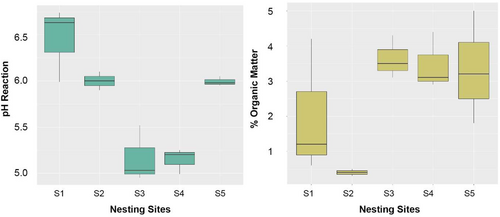
3.3 LEK and conservation concerns
A total of 146 turtle and tortoise hunters or egg collectors were interviewed to gather knowledge of the ecology and hunting of turtles and tortoises. Results of the interviews identified the Burmese softshell turtle and Burmese peacock softshell as the most well-known species. The Burmese softshell turtle was commonly observed in multiple habitats, including streams, grasslands, and forests, while the Burmese peacock softshell appeared to be predominantly found in lakes. The Burmese box turtle was reported to be abundant in forested areas (Figure 5). October was identified as the primary month for nesting, with April and July noted as hatching months (Figures S2 and S3). The clutch sizes of turtles and tortoises varied widely, ranging from 2 to 380 eggs (median 40).
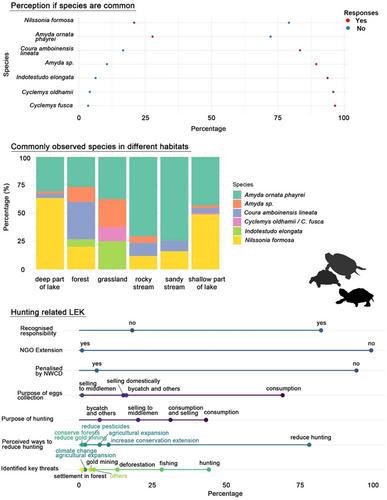
A quarter to a third of the respondents located nests and eggs by following footprints and signs of plastron rubbing on the ground. Most did not use specialized tools for hunting, though sticks were occasionally used to confirm the presence of nests. 78% believed that turtles and tortoises were mainly hunted by humans, though dogs (8%) and tigers (4%) were also identified as predators. The years 2009, 2014, and 2015 were noted for low turtle populations, with hunting cited as a major cause (Supporting Information S1: Figure S4). Turtles and tortoises were hunted both for consumption (above 43%) and for sale to middlemen (under 51%), while their eggs were mainly consumed (69%).
Only 1% of respondents reported that the Nature and Wildlife Conservation Division had engaged in conservation activities with them, primarily focusing on fish and birds. A small number of turtle hunters (6%) had been penalized for hunting. 82% felt they have a responsibility to conserve turtles and tortoises. They identified hunting (44%), fishing (28%), and deforestation (13%) as the main activities threatening turtle and tortoise populations. To counteract these threats, they recommended reducing hunting (78%) and increasing conservation extension activities (10%) as strategies for conserving turtles and tortoises (Figure 5).
4 DISCUSSION
Seven turtle and tortoise species (34 individuals) were sampled from Indawgyi Lake. Among these, the Burmese peacock softshell turtle, Burmese softshell turtle, Myanmar brown leaf turtle, and Burmese box turtle are species endemic to Myanmar. To our knowledge, this survey represents the first documented occurrence of the Myanmar brown leaf turtle and Oldham's leaf turtle at Indawgyi Lake. We also discovered an Amyda sp. with the vernacular name “Late Par Tate,” which appears to be a species not previously described. This species is absent from available records (refer to Platt et al., 2014; Vetter & VanDijk, 2006) and was unrecognized among the turtle and tortoise photo specimens checked by Dr. Rao Ding-Qi from the Kunming Institute of Zoology, Chinese Academy of Sciences. DNA samples have been collected from this species for DNA barcoding to ascertain if it is a new species.
As turtles are known for their selectiveness in choosing nesting sites, soil variables were expected to be the determining factor driving nest site selection. Results of our models, however, found disturbance (SW = 1.0) as the main explanatory estimator, followed by organic matter (SW = 0.52). This result is unsurprising given that turtles and tortoises, despite being the most threatened vertebrate group globally, have received little attention, even in the ILWS, a UNESCO Biosphere Reserve (UNESCO, 2019). In this region, most turtle and tortoise habitats are highly disturbed by agricultural, boat, and fishing activities. Consequently, areas where animals grazed became the sites where a greater number of nests were found.
Turtles typically prefer nesting sites with low organic matter, such as sandy loam, which is favorable for embryo incubation (Costanzo et al., 2001; Hughes & Brooks, 2006; Hughes et al., 2009). Therefore, the high organic matter indicated by our model may not accurately reflect turtles' habitat preferences but, instead, could be an artifact of the model. It is likely that sites with elevated organic matter were heavily utilized by various animals, including buffaloes, cows, and turtles, which in turn contributed to the increased organic matter content in the soils. Despite their preference for sandy loam sites, human disturbances may compel turtles to nest in less optimal habitats, such as the Shwe Taung Waterside. Although high organic matter could potentially increase mortality due to suffocation risks, both pH level and soil temperature in these areas remain within suitable ranges for turtle nesting. Moreover, the presence of tall Cogon grass (Imperata cylindrical) at nesting sites could benefit embryo survival rates by offering camouflage from humans and predators.
A high variation in clutch size (min. 2, max. 380) was reported by the local community, which appears to reflect intrinsic differences in breeding characteristics between species rather than extrinsic environmental factors. Local villagers noticed that the Burmese softshell turtles typically lay smaller clutches of 20–25 eggs, characterized by their large, circular shape. In contrast, Burmese peacock softshell turtles are known for larger clutches of 150–200 eggs, comprising smaller, circular eggs. Burmese box turtles and Oldham's leaf turtles tend to lay smaller clutches of 7–8 eggs with a cylindrical shape.
The results of this study may reflect biases arising from responses recalled by the interviewees. Despite this possible limitation, the gathered information can serve as valuable reference points in the absence of alternative data sources. For example, information about the locations where mother turtles lay eggs, along with nesting and hatching periods, can highlight crucial months for the protection of turtle nests, eggs, and hatchlings. Such insights are critical to elucidate the efforts required to help conserve and protect turtles and tortoises, especially considering that hunting (44%) and fishing (28%) have been identified as significant threats to turtle and tortoise populations in the ILWS.
The hunters described various hunting and egg collection practices. Some remove all the eggs from a nest, while others leave a few to ensure the survival of some offspring. During egg-laying, some hunters wait to collect only the eggs, whereas others capture both the mother turtle and her eggs. According to Platt et al. (2017), local fishermen trap turtles from December to April, when the river is at its lowest level during the dry season. However, according to the respondents, hunters, and fishermen set their traps along the shore during the rainy season when turtles swim to the lake's edge to lay their eggs (Supporting Information S1: Figure S2). This practice leads to the capture of numerous turtles, particularly pregnant females, that get ensnared in traps. Platt et al. (2017) suggested reducing or eliminating the use of monofilament gill nets to prevent the accidental capture of both turtles and dolphins.
Turtles and tortoises that were hunted were mostly consumed (above 43%) and sold to local middlemen (less than 51%), with some eventually entering the illegal trade. The Burmese Box turtle is highly sought after, fetching prices between 35,000 and 70,000 Kyats, equivalent to 17–34 USD. Interviewees indicated that a surge in market demand for turtles between 2014 and 2015 led to increased hunting, resulting in the perception of turtles and tortoises as being rare during that period. During interviews, the majority of the villagers showed their willingness to conserve turtles for the benefit of future generations, yet 99% reported a general lack of protection and conservation support from the Nature and Wildlife Conservation Division and NGOs. The observed trends in local hunting practices and perceptions suggest that conservation initiatives could be effectively targeted and managed at the local level.
The Wildlife and Protected Areas Law prohibits hunting without licenses, as well as killing, hunting, and transporting the seasonally protected or completely protected wildlife species. It also forbids processing these species as souvenirs or wearing them as part of traditional costumes (Chapter 11, Sections 35, 36, 27, 38, and 39) (SLORC, 1994). We recommend reinforcing law enforcement for wildlife conservation—imposing penalties for illegal hunting within the forestry, agriculture, and fishing sectors, focusing on the protection of habitats and nesting sites, and working with fishermen to ensure the release of turtles caught in nets during the breeding season. It is vital to expand conservation education and outreach activities (Kalra et al., 2023) for turtles and tortoises among local communities (e.g., via community meetings) and personnel involved in wildlife conservation, emphasizing the ecological and cultural importance of turtles and the legal ramifications of engaging in illegal trade. Training programs on conflict mitigation (e.g., coexistence strategies, fencing, safe handling, and relocating wildlife when necessary), understanding the legal framework and policies, and workshops on wildlife monitoring and data collection to develop target mitigation strategies will be beneficial.
Given that the illegal trade often involves local middlemen, there are opportunities to support alternative livelihoods, reducing their dependence on income from the illegal wildlife trade. Furthermore, increasing efforts by authorities, such as customs officials, to curb illegal cross-border and online trade is crucial (TRAFFIC, 2008). The establishment of dedicated cybercrime units to dismantle illegal wildlife trade activities online (TRAFFIC, 2019), along with bolstering international cooperation (e.g., through CITES) to enforce regulations and share intelligence about illegal trade networks, could enhance efforts against all forms of illegal wildlife trade.
In the vicinity of the ILWS, consideration must be given to regulating buffer zone management practices (Ministry of Water Resources, 2013). This is essential for promoting habitat conservation for aquatic ecosystems, which includes restricting or limiting pesticide use and encouraging sustainable farming. These practices would not only benefit wildlife but also enhance the living conditions of people residing in the area.
5 CONCLUSION
The ILWS stands as a global biodiversity hotspot of great biological significance, and this study highlighted the area's importance as a key Testudines habitat, especially with the discovery of a rare or possibly new species, Amyda sp. Although turtles' breeding and survival are known to be strongly influenced by soil quality, human disturbance plays a significant role in deterring them from nesting in suitable breeding grounds. Local communities, many of whom are fishermen or hunters, possess extensive knowledge of turtle nesting habits. A considerable number have hunted turtles and tortoises for personal consumption or sale through middlemen involved in international illegal trade. The findings of this study suggest that conservation efforts could be more effective with the active participation of local communities, as most hunters are from these communities. Furthermore, allocating sufficient resources and expanding conservation outreach specifically for turtle and tortoise protection could significantly enhance conservation outcomes in the region.
AUTHOR CONTRIBUTIONS
Ei Mon Kyaw and Lisa Ong formulated the research questions, did the data analysis, and wrote the manuscript. Ei Mon Kyaw, Nay Htet Naing, Thet Myat Oo, Kyaw Htet Naing, La Minn KoKo, and Thinn Su Tin contributed to field data collection. Xiao-Yong Chen supervised the manuscript.
ACKNOWLEDGMENTS
This work was funded by the Southeast Asia Biodiversity Research Institute, the Chinese Academy of Sciences (Grant/Award Number: Y4ZK111B01 and Y4ZK111B05), and the Yunnan Province Science and Technology Department (202203AP140007). Specimen photos of turtles and tortoises were reviewed and confirmed by Dr. Rao Ding-Qi from the Kunming Institute of Zoology, Chinese Academy of Sciences.
CONFLICT OF INTEREST STATEMENT
The authors declare no conflicts of interest.
Open Research
DATA AVAILABILITY STATEMENT
The data that supports the findings of this study are available in the supplementary materials of this article with the Comma-separated values (CSV) format.



